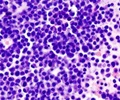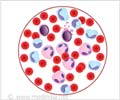Researchers at the University of Pennsylvania School of Medicine have identified a new protein associated with acute myelogenous leukemia (AML).
Researchers at the University of Pennsylvania School of Medicine have identified a new protein associated with acute myelogenous leukemia (AML). Several lines of evidence point to a protein called Tribbles , named after the furry creatures that took over the starship Enterprise in the original Star Trek series. Tribbles was first described in fruit flies.
“Tribbles had never been directly linked to human malignancy,” says senior author Warren S. Pear, MD, PhD, Associate Professor of Pathology and Laboratory Medicine. “This is a new protein to human cancer and has a specific and overwhelming effect when expressed in hematopoietic stem cells, the cell type that gives rise to all elements of the blood.”Three lines of evidence implicate Tribbles in AML. First, all mice engineered to express Tribbles-2 (Trib-2) in hematopoietic stem cells developed AML. They also found that Trib-2 inhibited C/EBP?, another protein that is frequently mutated in AML patients. Additionally, expression of the Tribbles protein was elevated in blood samples from AML patients, further suggesting that it contributes to AML. Overall, the findings suggest that Tribbles induces AML by inactivating the C/EBP? protein. The results were published in this week’s issue of Cancer Cell.
AML is a malignancy that arises in white blood cells and develops when there is a defect in immature immune cells in the bone marrow. In AML, the uncontrolled, exaggerated growth and accumulation of white blood cells leads to anemia and a deficiency of normal white cells in the blood. AML is the most common type of leukemia in adults, with an estimated 10,100 new cases reported each year.
Pear, also a researcher in the Abramson Family Cancer Research Institute at Penn; first author and postdoctoral fellow Karen Keeshan, PhD; and colleagues found Tribbles by chance when looking for the molecular partners of another protein called Notch. Notch is a molecular switch of sorts, activating gene transcription in the nucleus of many types of cells, and depending on the biochemical context, turns certain pathways on and others off.
Pear and colleagues knew from fruit fly studies that the Tribbles protein was linked to cell growth and cell-fate determination and is closely related to the Tribbles gene in mammals. In fact, Tribbles is so named because, when mutated in flies, it causes cells to proliferate uncontrollably.
Accumulating evidence from several groups shows that Tribbles functions as a scaffold to bring together a complex that mediates protein degradation. Protein degradation is required for normal cellular function; however, data from the Pear lab suggests that mistakes in the expression of the Tribbles gene may lead to degradation of proteins that hold cancer in check, such as tumor suppressors. “One of our current challenges is to determine what other proteins Tribbles degrades to cause leukemia,” says Pear.
Advertisement
According to Keeshan, “C/EBPa defects have also been identified in lung cancer and other tumors, suggesting the possibility that Trib2 dysregulation may be identified in other tumors. Furthermore, linking Trib2 to human cancer adds further support to the notion that targeting the protein degradation machinery will be a useful strategy in treating malignancy.”
Advertisement
SRM









